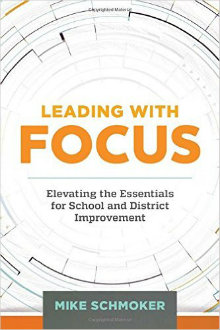Leading with Focus Will Improve Schools
Leading with Focus: Elevating the Essentials for School and District Improvement
By Mike Schmoker
(ASCD, 2016 – Learn more)

Leading with Focus: Elevating the Essentials for School and District Improvement is a follow-up to Mike Schmoker’s best seller Focus: Elevating the Essentials to Radically Improve Student Learning (ASCD, 2011). In his newest book, Schmoker provides a companion to this previous text.
The primary audience as suggested in the subtitle are teacher leaders, school principals, curriculum directors, and district superintendents. Checking at a lean 116 pages, Schmoker understands the busy lives of administrators in keeping this professional resource succinct.

- A coherent, content-rich curriculum
- A solid amount of traditional literacy tasks and activities
- Effective, soundly structured lessons
Within these three elements, Schmoker provides a step-by-step action plan for educational leaders to implement in order for these initiatives to be understood, applied, and institutionalized within the administrator’s current context (14-25):
Step 1: Research – Carefully
“Leaders need to make rational, hard-headed choices about what works.”
Step 2: Reduce – Until it Hurts
“When will we learn that even one new initiative requires far more time for training, practicing, and monitoring than leaders typically allot?”
Step 3: Clarify – Obsessively
“To achieve such clarity, leaders must ensure that someone on their staff explains and teaches and models critical concepts and practices multiple times, with follow-up and reinforcement, probably for the length of the teachers’ careers.”
Step 4: Practice – Repeatedly
“Teachers need leaders who aren’t bashful about the need to strenuously and repeatedly clarify and provide practice opportunities for teachers to learn and over-learn the fundamentals.”
Step 5: Monitor – and Respond Immediately
“To the greatest extent possible, monitoring should be a positive and productive process. We can ensure this by focusing on practices that teachers have had ample opportunity to learn and rehearse until they reach mastery.”
Schmoker does not even believe that a school or district has to focus on all three elements; any one of these areas will do when educational leaders want to prioritize their professional learning efforts.
For example, in Chapter 3 the author provides real examples of schools and districts that did not fully implement all three areas of focus. “Indeed, all have something to learn from each other. Even so, each school reveals the power of clarity, redundancy, and simplicity by focusing on one or more of the three fundamental elements discussed here to the exclusion of most everything else” (61).
This information should be heartening for school and district leaders who are concerned about initiative overload with their faculty.
So…does it work?
As an assistant principal at a middle school for four years, I heeded the power of focus. Our leadership team decided to adopt Robert Marzano’s nine recommended instructional strategies from his resource *Classroom Instruction That Works* (ASCD, 2004, 2012).
For each year, we explored and implemented three strategies. Professional development time was devoted to understanding how to set objectives and provide feedback, reinforce effort and provide recognition, and apply cooperative learning.
Teachers were encouraged to try it in their classrooms and report back at the next professional development session to celebrate their efforts and share their reflections. The result: Our school was recognized by the state department of education for reading growth with our eighth grades on the annual test.
Leading in reality
Mike Schmoker would qualify our middle school’s efforts as a focus on sound instruction. These efforts did not happen in a vacuum. A considerable amount of trust and the development of relationships between teachers and the administrative team, as well as among the faculty members themselves, were necessary for improvement.
Schmoker alludes to this in his section on monitoring instruction and responding immediately. “Under these conditions, monitoring should mostly consist of capturing and celebrating progress and increased consistency, with plenty of opportunities to compliment practitioners” (24).
Yet there is much more to building trust and relationships. As a principal in a new school, I have spent a large amount of my first months noticing what’s going well in classrooms, both in person and with small notes of appreciation. I’ve also tried to reveal myself as a learner first. These efforts were and are essential as we forge ahead in focusing on the reading-writing connection this spring.
A book worthy of a leader’s time
Despite the lack of discussion on the importance of trust before starting any kind of sustained initiative, Schmoker sticks to what made his excellent resource Focus a success. I recommend school and district leaders read both texts in either order to fully appreciate what the author is trying to convey. There is little doubt that when an organization applies the elements that Schmoker recommends, improved student achievement will be the result.
Matt Renwick is a veteran elementary school principal and former classroom teacher. He served as an assistant principal and athletic director in a middle school for four years. Matt writes for ASCD and Lead Literacy and is a frequent blogger.



































Sounds like a realistic book for administrators. Thanks for the review.